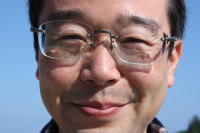About Satoshi Takahashi
 Satoshi Takahshi, Ph.D
Satoshi Takahshi, Ph.D
Associate Professor, Hiroshima City University
3-4-1 Ozuka-Higashi, Asa-Minami, Hiroshima 731-3194 Japan
Profile
I am interested in radiowave applications such as wireless communications and radar systems, and conducting related experiments and computer simulations. Wireless communications are familiar to us as smartphones, but here it refers to data transmission in free space. So far, I have been engaged in research on radio propagation analysis methods, inter-vehicle communication methods, signal processing methods for high-speed mobile wireless, and methods for detecting weak radio waves. I would like to achieve results conducting research on both practice and theory.
Short Biography
- Apr. 2005-Present Associate Professor, Hiroshima City University, Japan
- Apr. 2002-March 2005 Researcher, Communications Research Laboratory (Now, National Institute of Communications Technology), Japan.
- July 1996-October 1997 Research Fellow, Communications Research Laboratory, Japan.
- Apr. 1996-June 1999 Researcher, YRP Mobile Communications Key Technology Research Laboratory, Co., Ltd., Japan.
- Apr. 1995-March 2002 Engineer, Hitachi, Ltd., Japan.
- Apr. 1992-March 1995 Researcher, Hitachi, Ltd., Japan.
- March 1992 Master of Engineering, Tokyo Denki University, Japan.
- March 1990 Bachelor of Engineering, Tokyo Denki University, Japan.
Research Activity
- I have proposed the “Evaluation Point Culling Method” that calculates radio wave propagation in a shorter time and the “Random Phase Ray Tracing” that calculates radio wave propagation more precisely. I implemented these proposed methods using the programming language C++ and put it into practical use for cell designing tool of indicating optimum locations of base stations. The achievements were published in the Nikkan Kogyo Newspaper on October 14, 1994.
- While in YRP Key Tech Labs, we developed a delay profile measurement equipment that precisely measures the space in which radiowaves travel. It had a 100-MHz bandwidth in the 3 GHz, 8 GHz, and 16 GHz bands. We obtained radio experiment station license from the Ministry of Internal Affairs and Communications, and conducted experiments in the Tokyo areas. The results were the world’s first delay profile (radiowave path) that propagates over 1 km (September 1998). The proposed radiowave propagation models based on these measurements were approved as a revised proposal of the international standard recommendation ITU-R P.1411 (Method of estimating radio wave propagation). While in National Institute of Communication Technology, we developed a high-speed communication system between automobiles using 60 GHz charged waves, and showed the possibility of application to safety information transmission and automatic brake assistance from the measured data (October 2003).
- I have carried out analyzing characteristics of MIMO (multiple-input multiple-output) mobile wireless communications, cognitive radios that recognize the surrounding radiowave environment and set up communication parameters themselves, collision avoidance car-borne radars, and emergency wake-up receivers.
- In mobile radio communications, there is often a gap between theory and practice, and my life work is to fill that gap.
Memberships
- Member of IPNTJ (The Institute of Positioning, Navigation and Timing of Japan) (2018-present)
- Senior member of IEICE (The Institute of Electronics, Information and Communications Engineers) (1989-present)
- Member of IEEE (The Institute of Electrical and Electronics Engineers) (1995-present)
- Member of ITE (The Institute of Image Information and Television Engineers) (2010-present)
Member of SITA (Society of Information Theory and its Applications) (2003-2008)Member of IPSJ (Information Processing Society of Japan) (1990-2021)
Awards
- Activity Achievment Award (communication systems technical committee) from The Institute of Electronics, Information and Communications Engineers (IEICE), Sept. 2022.
- Activity Achievment Award (paper review) from The Institute of Electronics, Information and Communications Engineers (IEICE), Sept. 2019.
- Activity Achievment Award (paper review) from The Institute of Electronics, Information and Communications Engineers (IEICE), Sept. 2016.
- Activity Achievment Award (secretary of communication systems technical committee) from The Institute of Electronics, Information and Communications Engineers (IEICE), Sept. 2016.
- Activity Achievment Award (paper review) from The Institute of Electronics, Information and Communications Engineers (IEICE), Sept. 2012.
- Activity Achievment Award (paper review) from The Institute of Electronics, Information and Communications Engineers (IEICE), Sept. 2009.
- Activity Achievment Award (paper review) from The Institute of Electronics, Information and Communications Engineers (IEICE), Sept. 2006.
- Telecom System Technology Award from The telecommunications Advancement Foundation (TAF), March 2003.
- IEEE Antennas and Propagations Society Japan Chapter, Young Engineer Award, Dec. 2000.
- Academic Encouragement Award from The Institute of Electronics, Information and Communications Engineers (IEICE), March 1999.